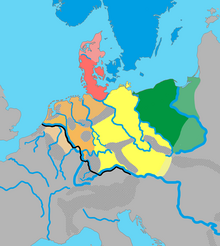lingvo.wikisort.org - Language
Elbe Germanic, also called Irminonic or Erminonic,[1] is a term introduced by the German linguist Friedrich Maurer (1898–1984) in his book, Nordgermanen und Alemanen, to describe the unattested proto-language, or dialectal grouping, ancestral to the later Lombardic, Alemannic, Bavarian and Thuringian dialects. During Late antiquity and the Middle Ages, its supposed descendants had a profound influence on the neighboring West Central German dialects and, later, in the form of Standard German, on the German language as a whole.[2]
| Elbe Germanic | |
|---|---|
| Irminonic, Erminonic | |
| Ethnicity | Irminones |
| Extinct | Developed into High German dialects |
Language family | Indo-European
|
| Language codes | |
| ISO 639-3 | – |
 The distribution of the primary Germanic languages in Europe c. AD 1:
North Germanic
North Sea Germanic, or Ingvaeonic
Weser-Rhine Germanic, or Istvaeonic
Elbe Germanic, or Irminonic
East Germanic † | |
Nomenclature
The term Irminonic is derived from the Irminones, a culturo-linguistic grouping of Germanic tribes that was mentioned by Tacitus in his Germania.[3] Pliny the Elder further specified its meaning by claiming that the Irminones lived "in the interior", meaning not close to the Rhine or North Sea.[4] Maurer used Pliny to refer to the dialects spoken by the Suevi, Bavarii, Alemanni and Lombards around the Hercynian Forest and the Northeastern German plain.[5]
Theory
Mauer asserted that the cladistic tree model, which was used ubiquitously in linguistics in the 19th and the early 20th centuries, was too inaccurate to describe the relation between the modern Germanic languages, especially those belonging to its Western branch. Rather than depicting Old English, Old Dutch, Old Saxon, Old Frisian and Old High German to have simply 'branched off' a single common 'Proto-West Germanic', which many previous linguists equated to "Old German / Urdeutsch", he assumed that there had been much more distance between certain dialectal groupings and proto-languages.[6]

See also
- North Sea Germanic
- Rhine-Weser Germanic
References
- R.D. Fulk (15 September 2018). A Comparative Grammar of the Early Germanic Languages. John Benjamins Publishing Company. pp. 17f. ISBN 978-90-272-6313-1.
- Friedrich Maurer (1942) Nordgermanen und Alemannen: Studien zur germanische und frühdeutschen Sprachgeschichte, Stammes- und Volkskunde, Strasbourg: Hünenburg.
- Tac. Ger. 2
- Plin. Nat. 4.28
- Friedrich Maurer (1942) Nordgermanen und Alemannen: Studien zur germanische und frühdeutschen Sprachgeschichte, Stammes- und Volkskunde, Strasbourg: Hünenburg.
- Johannes Hoops, Heinrich Beck, Dieter Geuenich, Heiko Steuer: Reallexikon der germanischen Altertumskunde: Band 7; Walter de Gruyter, 1989, ISBN 9783110114454 (pp 113–114).
Bibliography
- Grimm, Jacob (1835). Deutsche Mythologie (German Mythology); From English released version Grimm's Teutonic Mythology (1888); Available online by Northvegr © 2004–2007:Chapter 15, page 2-; 3. File retrieved 11-18-2015.
- Tacitus, Germania (1st century AD). (in Latin)
- Friedrich Maurer (1942) Nordgermanen und Alemannen: Studien zur germanische und frühdeutschen Sprachgeschichte, Stammes- und Volkskunde, Strasbourg: Hünenburg.
- James, Edward (1988). The Franks. The Peoples of Europe. Oxford, UK; Cambridge, Massachusetts: Basil Blackwell. ISBN 0-631-17936-4.
- Gregory of Tours (1997) [1916]. Halsall, Paul (ed.). History of the Franks: Books I–X (Extended Selections). Medieval Sourcebook. Translated by Ernst Brehaut. Columbia University Press; Fordham University.
Другой контент может иметь иную лицензию. Перед использованием материалов сайта WikiSort.org внимательно изучите правила лицензирования конкретных элементов наполнения сайта.
WikiSort.org - проект по пересортировке и дополнению контента Википедии